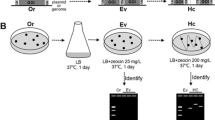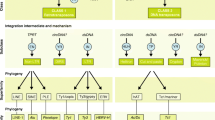Abstract
The unstable white-S2 (w S2) allele of the white gene occurred spontaneously in the S2 strain of Drosophila simulans. This mutation was caused by insertion of the submariner element, a mariner-like element with an abnormal tandem duplication of the 5' inverted terminal repeat (ITR). Although it has an incomplete ITR, submariner excises efficiently. The rate of somatic reversion, estimated by the number of eye-color mosaic flies, was 79.9%, and the reversion frequency in the germline was 0.6%. The change to the 5' ITR contributes to make this transposon precise excision.
Similar content being viewed by others
References
Augé-Gouillou, C., H. Notareschi-Leroy, P. Abad, G. Periquet & Y. Bigot, 2000. Phylogenetic analysis of the functional domains of mariner-like element (MLE) transposases. Mol. Gen. Genet. 264: 506–513.
Augé-Gouillou, C., M.H. Hamelin, M.V. Demattei, M. Periquet & Y. Bigot, 2001. The wild-type conformation of the Mos-1 inverted terminal repeats is suboptimal for transposition in bacteria. Mol. Genet. Genomics 265: 51–57.
Bryan, G.J. & D.L. Hartl, 1988. Maternally inherited transposon excision in Drosophila simulans. Science 240: 215–217.
Bryan, G.J., D. Garza & D. Hartl, 1990. Insertion and excision of the transposable element mariner in Drosophila. Genetics 125: 103–114.
Capy, P., A. Koga, J.R. David & D.L. Hartl, 1992. Sequence analysis of active mariner elements in natural populations of Drosophila simulans. Genetics 130: 499–506.
Carr, B. & P. Anderson, 1994. Imprecise excision of the Caenorhabditis elegans transposon Tc1 creates functional 5′ splice sites. Mol. Cell. Biol. 14: 3426–3433.
Church, G.M. & W. Gilbert, 1984. Genomic sequencing. P. Natl. Acad. Sci. USA 81: 1991–1995.
Doak, T.G., F.P. Doerder, C.L. Jahn & G. Herrick, 1994. A proposed superfamily of transposase genes: transposon-like elements in ciliated protozoa and a common 'D35E' motif. P. Natl. Acad. Sci. USA 91: 942–946.
Giraud, T. & P. Capy, 1996. Somatic activity of the mariner transposable element in natural populations of Drosophila simulans. P. Roy. Soc. Lond. B. Bio. 263: 1481–1486.
Hartl, D.L., 1989. Transposable element mariner in Drosophila species, pp. 531–536 in Mobile DNA, edited by DE. Berg & M.M. Hower. American Society for Microbiology, Washington.
Hartl, D.L., 2001. Discovery of the transposable element mariner. Genetics 157: 471–476.
Inoue, Y.H., T. Taira & M.-T. Yamamoto, 1988. Genetics of an unstable white mutant in Drosophila simulans: reversion, suppression and somatic instability. Genetics 119: 903–912.
Lampe, D.J., M.E. Churchill & H.M. Robertson, 1996. A purified mariner transposase is sufficient to mediate transposition in vitro. EMBO J. 15: 5470–5479.
Lohe, A.R. & D.L. Hartl, 2002. Efficient mobilization of mariner in vivo requires multiple internal sequences. Genetics 160: 519–526.
Lohe, A.R., C. Timmons, I. Beerman, E.R. Lozovskaya & D.L. Hartl, 2000. Self-inflicted wounds, template-directed gap repair and a recombination hotspot: effects of the mariner transposase. Genetics 154: 647–656.
Maruyama, K. & D.L. Hartl, 1991. Evolution of the transposable element mariner in Drosophila species. Genetics 128: 319–329.
O'Brochta, D.A., S.P. Gomez & A.M. Handler, 1991. P-element excision in Drosophila melanogaster and related Drosophilids. Mol. Gen. Genet. 225: 387–394.
O'Hare, K., C. Murphy, R. Levis & G.M. Rubin, 1984. DNA sequence of the white locus of Drosophila melanogaster. J. Molec. Biol. 180: 437–455.
Sambrook, J., E.F. Fritsch & T. Maniatis, 1989. Molecular Cloning. A Laboratory Manual. Cold Spring Harbor Laboratory Press, Cold Spring Harbor, N.Y., 2nd edn.
Uenoyama, T. & Y. Inoue, 1995. Genetic studies on premating isolation in Drosophila simulans. Jpn. J. Genet. 70: 367–373.
van Luenen, H.G., S.D. Colloms & R.H. Plasterk, 1994. The mechanism of transposition of Tc3 in C. elegans. Cell 79: 293–301.
Author information
Authors and Affiliations
Corresponding author
Rights and permissions
About this article
Cite this article
Ogura, K., Yamamoto, MT. A mariner-like element with a 5' lesion in Drosophila simulans . Genetica 119, 229–235 (2003). https://doi.org/10.1023/B:GENE.0000003602.98863.67
Issue Date:
DOI: https://doi.org/10.1023/B:GENE.0000003602.98863.67




